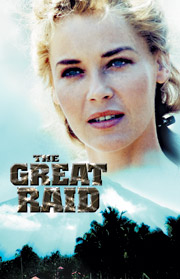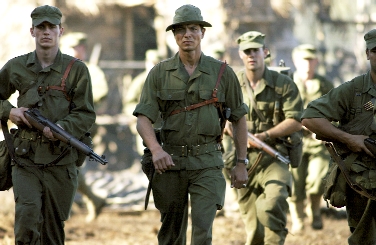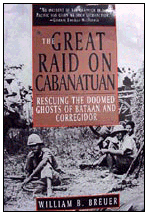|
Movie Review: 'The Great Raid'
by Steven Clark
15 September 2005
 The most successful rescue mission in American military history was the 1945 raid on the Cabanatuan prison camp in the Philippines. Army rangers saved more than 500 Americans from certain death, and "The Great Raid" is a strong movie about this, told in a straightforward, detailed manner by director John Dahl.
The most successful rescue mission in American military history was the 1945 raid on the Cabanatuan prison camp in the Philippines. Army rangers saved more than 500 Americans from certain death, and "The Great Raid" is a strong movie about this, told in a straightforward, detailed manner by director John Dahl.
The movie begins with American POWs taken by Japanese troops and tossed into bunkers where they are burned alive. The Japanese, who despised the Americans for surrendering in 1942 and not fighting to the death, are ready to kill them off rather than see them freed by the American army. This ticking clock is always in the background and maintains the tension while the rangers, commanded by Lt. Colonel Mucci (Benjamin Bratt), figure out the quickest and most effective way to free the prisoners. Mucci's aide, Captain Prince (James Franco), questions the colonel's methodical planning, and his voice-over narration provides commentary on the mission, which was executed in a five-day period. The film avoids the usual Hollywood 20 camera-shots-a-minute and 'acting' histrionics to tell a solid story of the rescue. Mucci's concerns are real: his rangers are untested in battle, they must go deep in enemy territory where they are outnumbered, and have only one chance to pull the raid off. Filipino guerillas chafe at their assigned support role; they want to get even for what the Japs have done to their people and prove themselves as soldiers.
 The plan and march contrast with the prison camp, which is shown in grim, stark terms. Hundreds of graves surround it, and the Japs have kept food parcels and medical supplies from the POWs as a matter of course. Major Gibson (played by Joseph Fiennes), the senior commanding officer of the POWs, has to keep his men together and alive, and also try to stop Red (Martin Csokas), a POW. from trying to escape because if one POW escapes, the Japs will kill ten remaining POWs. Gibson is slowly dying of malaria, but refuses to aid the Japanese in exchange for medicine. He is weak but not beaten. What keeps Gibson going is not so much his patriotism (like most POWs, he feels FDR abandoned him and his men in 1942), but his uncommsumated love for Margaret (Connie Nielsen), a nurse in Manila who secretly smuggles him quinine while working with the Philippine resistance. The love story is essential as it shows the horrible price paid by the Filipinos for resisting the Japs, and a human factor of survival that balances the planning for the raid and survival in the camp.
The plan and march contrast with the prison camp, which is shown in grim, stark terms. Hundreds of graves surround it, and the Japs have kept food parcels and medical supplies from the POWs as a matter of course. Major Gibson (played by Joseph Fiennes), the senior commanding officer of the POWs, has to keep his men together and alive, and also try to stop Red (Martin Csokas), a POW. from trying to escape because if one POW escapes, the Japs will kill ten remaining POWs. Gibson is slowly dying of malaria, but refuses to aid the Japanese in exchange for medicine. He is weak but not beaten. What keeps Gibson going is not so much his patriotism (like most POWs, he feels FDR abandoned him and his men in 1942), but his uncommsumated love for Margaret (Connie Nielsen), a nurse in Manila who secretly smuggles him quinine while working with the Philippine resistance. The love story is essential as it shows the horrible price paid by the Filipinos for resisting the Japs, and a human factor of survival that balances the planning for the raid and survival in the camp.
The raid itself is well-staged and paced with enough understanding so the audience catches how a raid must be planned and executed successfully. It also shows the effective use of firepower: the Japs' Arisaka bolt-action rifles are no match for the M-1s. A good, solid battle.
 Based on the book The Great Raid: Rescuing The Doomed Ghosts of Batann and Corrigidor, director Dahl has made a strong, compelling film. It is helped by newsreel footage of the aftermath of the raid and return of the POW's home. It took two years to get this film out of post-production, and the critics have roughed it up for being too flag-waving, showing the Japanese as cartoon villains (actually, they are shown realistically if brutally), and the story told too slowly. It also has no blacks except for newsreel clips of one or two faces a crowd, and we can judge that showing too much white bread gets a no-go for the critics, but "The Great Raid" is a strong, measured piece of filmaking. It reminded me of another great movie, "Northwest Passage"...an earlier rescue mission/search and destroy assault by American rangers. I couldn't help noticing the night I watched the film that there was a coming attraction about a new movie centering on the war in Iraq with darky Jamie Foxx featured, shouting the usual rap lingo ''bout servin' in de ahmy.' I'll take "The Great Raid."
Based on the book The Great Raid: Rescuing The Doomed Ghosts of Batann and Corrigidor, director Dahl has made a strong, compelling film. It is helped by newsreel footage of the aftermath of the raid and return of the POW's home. It took two years to get this film out of post-production, and the critics have roughed it up for being too flag-waving, showing the Japanese as cartoon villains (actually, they are shown realistically if brutally), and the story told too slowly. It also has no blacks except for newsreel clips of one or two faces a crowd, and we can judge that showing too much white bread gets a no-go for the critics, but "The Great Raid" is a strong, measured piece of filmaking. It reminded me of another great movie, "Northwest Passage"...an earlier rescue mission/search and destroy assault by American rangers. I couldn't help noticing the night I watched the film that there was a coming attraction about a new movie centering on the war in Iraq with darky Jamie Foxx featured, shouting the usual rap lingo ''bout servin' in de ahmy.' I'll take "The Great Raid."
STEVEN CLARK
|